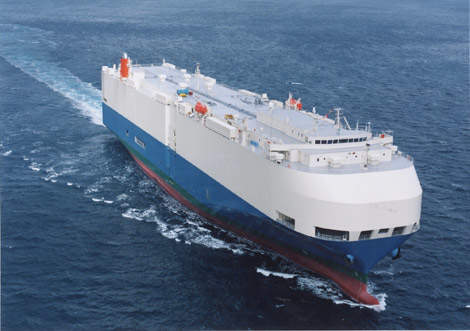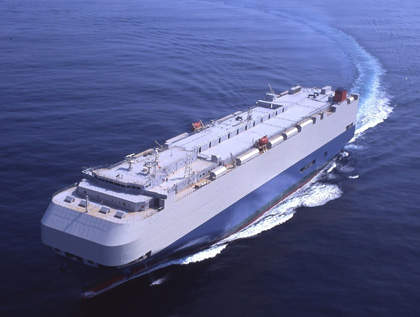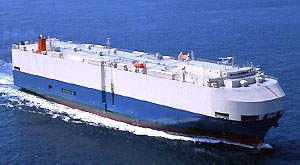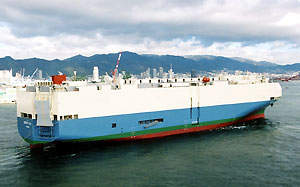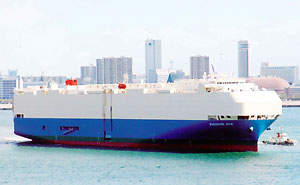A series of 12 new large car carriers, scheduled for delivery by Mitsui OSK Lines (MOL) before March 2007, began with Courageous Ace which was completed at the Minaminippon Shipbuilding yard. Heroic Ace and Splendid Ace were also built at the same yard. The sister ships Martorell, Progress Ace and Prominent Ace were built at the Shinkurshima yard. Liberty Ace, Utopia Ace, Paradise Ace and Freedom Ace were built at the Kobe Shipyard of Mitsubishi Heavy Industries in Japan.
The vessels have a length of 198m, or 188m between perpendiculars, and a width of 32.2m. The depth to the main deck is 14.6m and 33.7m to the upper deck. They have an 8.8m draught. The vessels register from 56,500t to 60,200t and have a 16,957t design deadweight. The carriers are staffed by a complement of ten officers and 20 crew.
VESSEL DESIGN
The vessels’ bows are aerodynamically rounded and bevelled along the bow line to help reduce pressure from headwinds and generally minimise wind resistance. Even the ships’ ventilation covers feature aerodynamically rounded sides.
The design effectively reduces leeway caused by wind pressure. As a result, the design improves both fuel efficiency – which in turn reduces emissions of CO2, NOx, and SOx in vessel engine exhaust – and speed.
Test results show a 20% reduction in aerodynamic pressure at the bow in winds of 15m/sec. This results in a 4% improvement in fuel efficiency. By reducing leeway, the design is expected to improve fuel efficiency by about 6%. The combined results will lead to an increase in speed of up to 1 knot, depending on the direction of the wind.
The vessels have a heavy oil bunker of 2,848m³. The main engine consumes 50.6t/day, with another 3.1t for the auxiliaries. The vessel design features double-hulled fuel tank to reduce the chance of oil spills in case of a grounding or collision.
PURE CAR / TRUCK CARRIER (PCTC)
In total, the vessels can accommodate 6,400 medium sized cars. In addition, 90% of the cargo space can accommodate tall vehicles, and the rampway supports 100t. There are 11 fixed and two hoistable decks within the main hull. There is also additional
space on the main deck.
The ramp/door access systems were designed by Tsuji Heavy industries. The main access to the shore is by means of a starboard quarter ramp as well as port and starboard side doors located on deck 7. There are a number of electrohydraulic internal
ramps between the floors.
POWER, PROPULSION AND MANOEUVRING
The main engine is a Mitsubishi-designed 8 UEC60LS unit, built by Kobe Diesel. This has an output of 14,160kW at 100rpm. The vessel features a spray oil injection system, resulting in a smaller amount of lubricating oil being used in the main engine cylinders and consequently reducing the ship’s emissions by 30%.
The engine drives a Nickel Aluminium Bronze propeller, designed and manufactured by Nakashima Propeller Co. The fixed pitch unit has a 6.55m diameter. It has a Propeller Boss Cap Fins (PBCF) to enhance efficiency by 4% to 5%. This gives the ships an operating speed of 20.65 knots.
There is also a Miura VWH-1600ME boiler with an output of 1.2t/hr.
Electric power is provided by three diesel-driven alternators. These consist of three Daihatsu 5DK-26 engines, each with an output of 1,070kW at 720rpm. Each are linked to a Nishishiba NTAKL-VE Alternator, which have an output of 1,000kW at a speed of 720rpm.
For manoeuvring in port, the vessels have a 1,250kW Kawasaki bow thruster, rotating at 1,160rpm. Mooring equipment is located in an optimised position and anchors and other equipment are positioned asymmetrically, helping to increase cargo capacity.
The ships use a NABCO bridge control system, while in the wheelhouse are a pair of Tokimec radar units.
The ships are classified by Nippon Kaji Kyokai (Class NK) under the notation NS, Vehicles Carrier, MNS, MO

